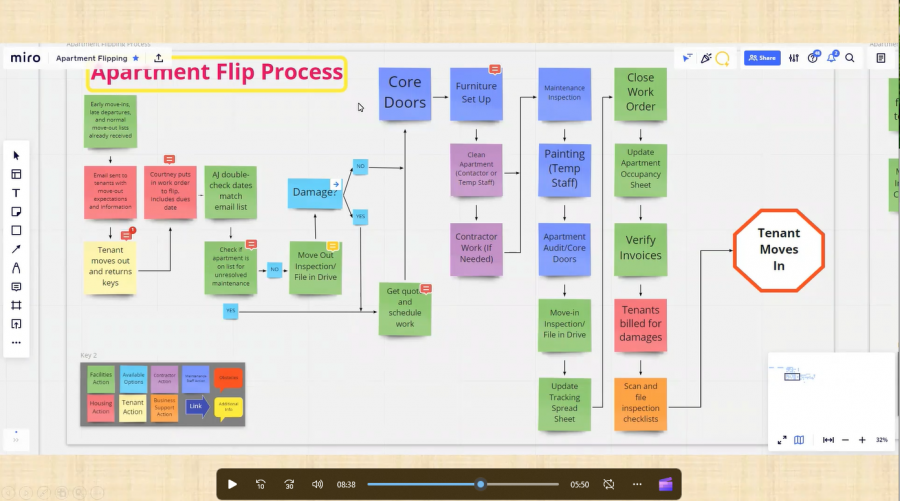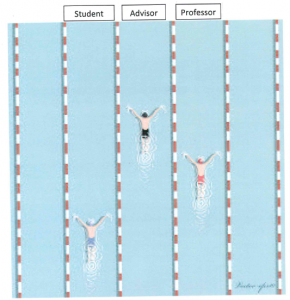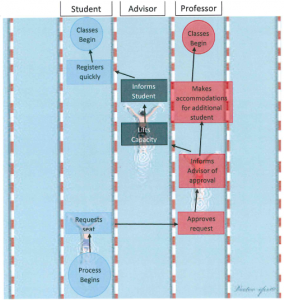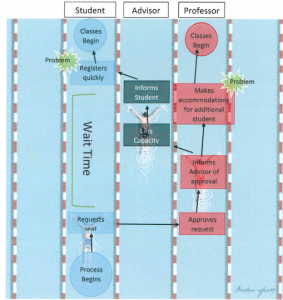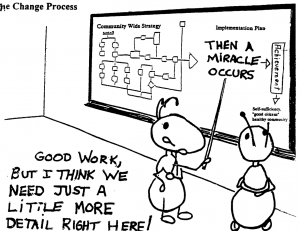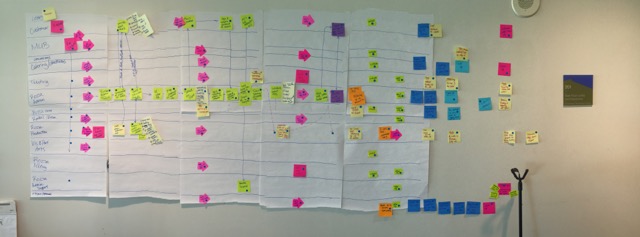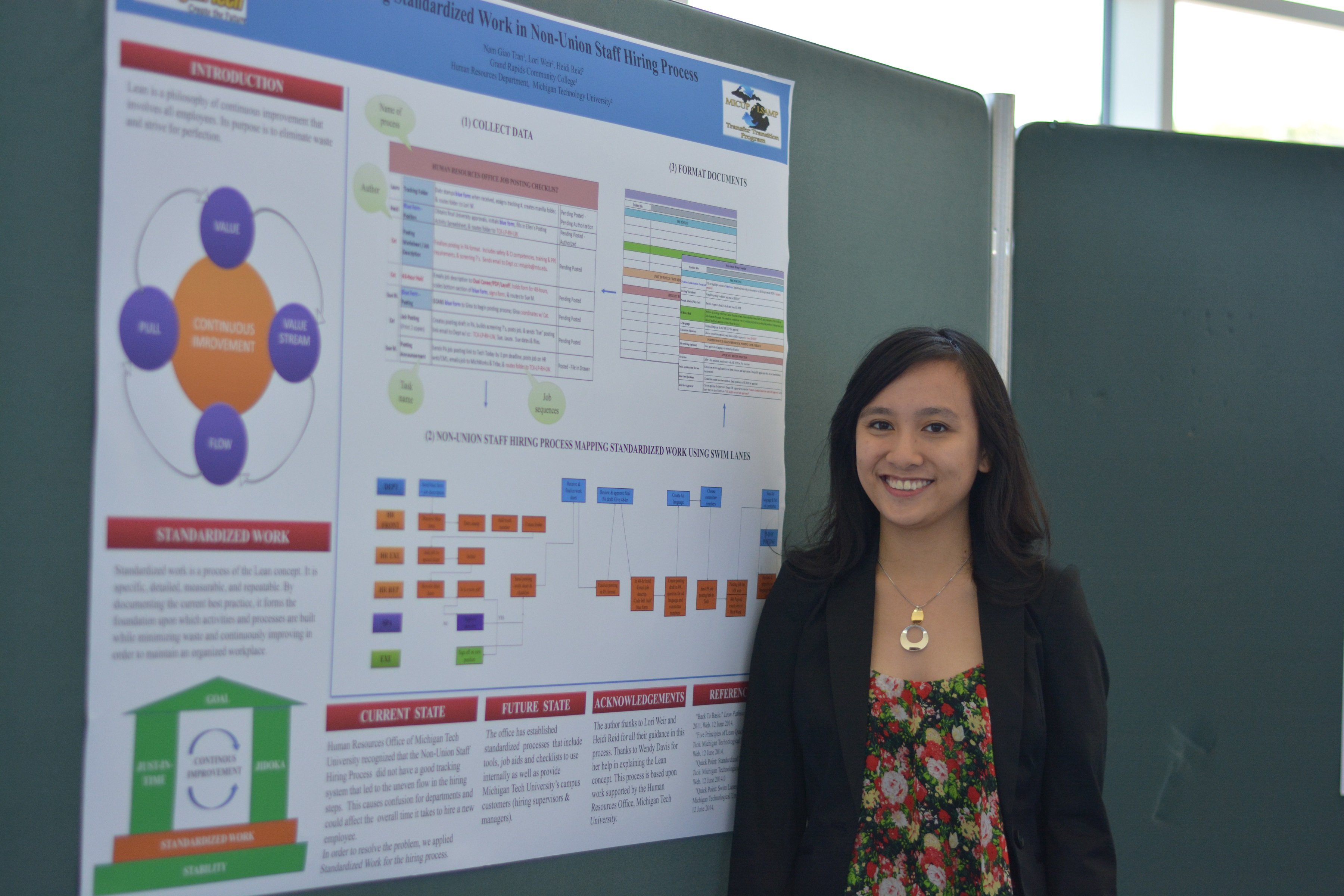AJ Mikus is the Facilities Manager for the Daniell Heights apartment complex at Michigan Technological University. AJ led an improvement event designed to improve the student experience of checking out of their apartments, reduce the amount of repairs needed, and ensure all damages were properly accounted for. Watch AJ’s report out on his kaizen experience at our Lean at Michigan Tech YouTube channel.
Data collection can be a tricky thing, especially in a Higher Education setting. We tend to have to get creative in identifying what data would be helpful in representing improvement, as well as how we can collect the data using the resources we already have. This need for creative thinking skills tends to make brainstorming a collection plan seem ambiguous and maybe even insignificant at times.
We can easily generate a process map for the current state and future state and then count how many steps were eliminated, but what if five steps were removed, and one was created? It would appear (numerically) as if four steps were removed. Which is true, but how can we account for the process change in the new step? How can we measure that the new process adds more value than the old process? How do we represent the waste of five steps versus one new step? This is where our creative thinking ends and we decide that removing four steps is “good enough.”
In a video I recently watched, Mike Wroblewski, a senior consultant from the Kaizen Institute, shared a little bit about all the things we should consider before we create a data collection plan. The part that really stuck with me was his emphasis on going to the Gemba, the place where work is done, and asking questions. Wroblewski’s video showed me, that you can’t fully grasp the current state until you immerse yourself in the environment of the user, even if it is only observation. Once you’ve gone to the Gemba, it becomes more clear what the steps in the process are. From here you can identify metrics that represent the frequency of an event, such as the number of corrections to file, or that represent importance. For example, how critical is it that this step be in the process at all.
By now you’re probably thinking, “this is all great, but why do we even care about metrics?” Results. When you think of a research project, you want to know the results. When you missed the ending of a baseball game, you want to know the results. When you hear of someone applying for a new job, you want to hear the results. We as humans are hard wired around, “what happened next?” Lean and Continuous Improvement is no exception to this. When an improvement event is initiated, we soon begin talking about data collection before and after a kaizen so that we have results to showcase the work that was done. Metrics can be the difference between a department hypothetically getting $500 towards improvement efforts or $50,000. Metrics and results drive more people to put in the energy to improve their work from good to great.
This outlook and approach towards data collection is one that our lean practitioners here on campus have been trying to implement more and more, as well creating a more systematic approach towards getting numbers easily, accurately, and that will also provide meaningful data.
So often we get caught up in our projects: we start them, prioritize them, and then devote all of our attention to them one by one until they’re completed. We very rarely have a single project that is on-going for a long period of time; why is this?
I think it’s because we don’t want lingering work, we thrive off of completion. From that we gain satisfaction and pride in our work.
There is, however, a trade-off for this pride. That is, when we continuously move from one project to the next, seeing each to completion before starting the next, most of us quickly become burned out. When we get burned out we lose our energy and our enthusiasm, as well as become negative, frustrated, and unproductive. That satisfaction we were chasing before no longer sustains us.
Back in February, one of my co-worker’s blogged on incremental improvement, and recently she blogged about Preemptive Improvement. In these blogs, she’s shared how our office has been using small improvements to achieve a high future state and strive for perfection, even when a correction isn’t necessary. These methods are some that I’ve been applying in my own personal life heavily in the last year or so.
Last July I got engaged, we set a date 11 months out and so commenced the wedding planning. For all those who’ve been married, you probably know the magnitude of this task. I’ve always been a “planner,” per say, and I tend to enjoy getting to use my creativity, so from the beginning I’ve been pretty excited about the planning process. However, I know a lot of people who’ve gotten married and I’ve learned that the entire process isn’t always fun, or creative. I also know myself and I tend to go and go and go, and focus on one thing until it’s complete before I’ll start the next; meaning, I tend to burn myself out.
Knowing the planning wouldn’t always play on my interests, and knowing that I sometimes overburden myself were good things to be aware of back in July. Because of this, I was able to plan ahead and use my lean thinking skills to combat potential burnouts or becoming a bridezilla (my worst nightmare). I did this by utilizing the skills I’ve learned here in the Office of Continuous Improvement. I can honestly, say with 10 days left until the wedding, that I’ve only had two “burnouts,” one as a result of over-processing, and the other was out of my control to change.
After talking to multiple soon-to-be wives, I’ve learned that I am the one who’s been the least bit stressed about the planning process as a whole and I believe this is from all of the lean I’ve implemented… From organizing my thoughts via a gigantic affinity diagram, laying out the roles and responsibilities of our family members in a swim lane, using a decision matrix to decide on venues and vendors, ICE prioritization of tasks, plentiful checklists, recognizing when I was over processing, and also taking it one step at a time and remembering that the entire wedding doesn’t need to be planned over-night.
I’ve also gathered that on average, the last three weeks before the wedding tend to be the busiest with wrapping up small details. However, because of the prioritization that we conducted early on, and the small deadlines we set, we were able to spend two of those weeks towards something not related to wedding, and only spend the last week wrapping up details.
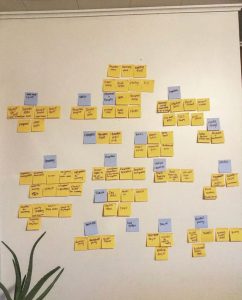
The purpose of today’s blog post is to show you that as long as you learn how to slow down your thinking, anyone can implement and benefit from small improvements striving for perfection.
There has been a new Kaizen started here in the Office of Continuous Improvement, and I get to be the PIC for it! The new Kaizen is through the JR Van Pelt and Opie Library. The topic will be based around the scheduling methods of conference room 103 in the Library. Chad Arney, Director of Strategic Initiatives, is the team leader. He has proven to be very knowledgeable, both in the understanding of Library itself and in Google calendar. Andrew Miles (Financial Aid Manager), Briana Tucker (Student Engagement Coordinator), and Lori Weir (Dir Admin Services & Projects) are the three facilitators that have volunteered for this Kaizen. An added bonus, is that they are all outside eyes, and often ask very formidable questions about the process for how to schedule the conference room. Our team members are Annelise Doll and Mia Kemppainen, both employees in the library who know the process inside and out, and work with it on a daily basis.
We held our pre-meeting at the beginning of the March and identified what the problem was exactly. Chad explained the confusion and difficulty there was just to reserve the conference room, which believe me, was very confusing, especially for an outsider looking in. It was a bit unbelievable to see the process that people have to go through to reserve this room. Not only is there a lengthy process, but there is all the potential for other people to be in the room or that another reservation could be made, over-booking your event.
We held our first Kaizen day this past Monday with the whole team together in one room. We were able to create a process map of what people have to do to reserve the room. We were also able to figure out some things in Google calendar that really none of us have really known about before, like knowing who can reserve the room on campus and how Google calendar can accept whether or not the room can be reserved. It was very interesting to learn about these new things I hadn’t known before. We were also able to identify the different things that people struggle with when reserving the room.
Overall, it’s been, and hopefully will continue to be a fun, exciting, and great learning experience.
For the last six months a team has been pulled together to address various areas of the commencement process here at Michigan Tech, from ticketing to safety, and from configuration of space to guest speakers. This team has covered the commencement process inside and out, and with all of the stakeholders involved too! That’s HUGE!! The team has met 13 times already, for a total of 20 hours, and they are just getting started on most of it.
Before I introduce the teams let me tell a little bit more about how the Office of Continuous Improvement and the commencement committee have paired up and identified the kaizens that they’d like to move forward on. The meetings mentioned used swim lanes, a process mapping tool to map out the commencement process. The details to go on the swim lanes were acquired by the team leader, Kelly Vizanko, who emailed all of the stake holders and asked for their timelines. For the ones that were not received via email, they attended half-hour segments to help the team map out their part of the process. These meetings then identified areas of waste using kaizen bursts. From there the kaizen bursts were grouped based on the sub-process that they fell into and then later placed into a ICE Table, used for prioritization. This is how the kaizens were identified, by the most important/greatest impact, the level of control the team had, and by the ease to implement change/improvement. The kaizens identified were: Ticketing, Preparation, Volunteers, and Space + Configuration.
Ticketing consisted of eight people:
- Kelly Vizanko (Registrar’s Office) – Team Leader
- Ashley DeVoge (Ticketing Office) – Team Leader
- Megan Goke (Office of Continuous Improvement) – Facilitator
- Rylie Store (Office of Continuous Improvement) – Process Improvement Coordinator
- Alisha Kocjan (Registrar’s Office) – Team Member
- Shanda Miller (Bookstore) – Team Member
- Nancy Byers-Sprague (Graduate School) – Team Member
- Mary Stevens (Graduate School) – Team Member
This kaizen is wrapping up soon with a report out to the commencement committee. Several changes are expected such as scanning tickets to track the number of bodies in the room, communication to students (undergraduate and graduate) streamlined, established a limit for how many tickets will be issued, etc…
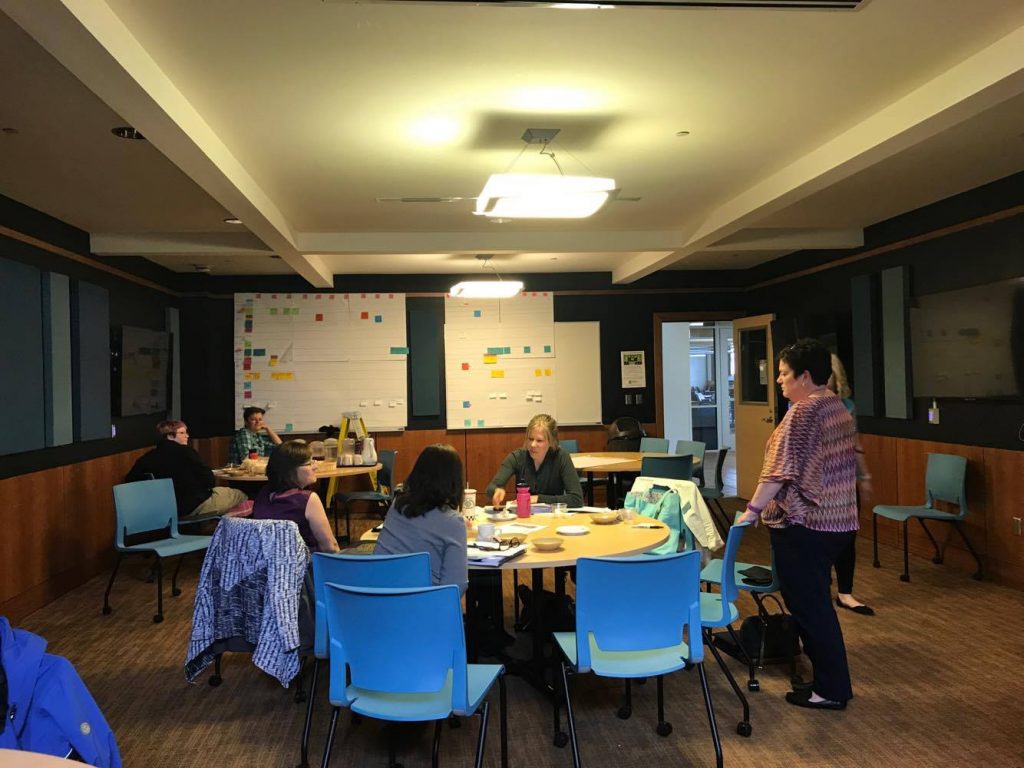
The Commencement Volunteers and Preparation kaizens are just about to take off, all we are waiting on is the dates to come (for the volunteer kaizen) and our team to be solidified for the preparation kaizen.
The team for volunteers is:
- Kelly Vizanko – Team Leader
- Gina LeMay (Research Office) – Facilitator
- Megan Goke – Facilitator
- Rylie Store – PIC
- Alisha Kocjan – Team Member
- Joel Isaacson (Athletics) – Team Member
- Jennifer Biekkola (Alumni House) – Team Member
- Brian Cadwell (Public Safety & Police Services (PSPS))- Team Member
- Daniel Bennett (University Safety & Security – PSPS) – Team Member
And to kick off the Preparation Kaizen we have:
- Kelly Vizanko – Team Leader
- Alisha Kocjan – Team Leader
- Laura Harry (Memorial Union) – Facilitator
- Rylie Store – PIC
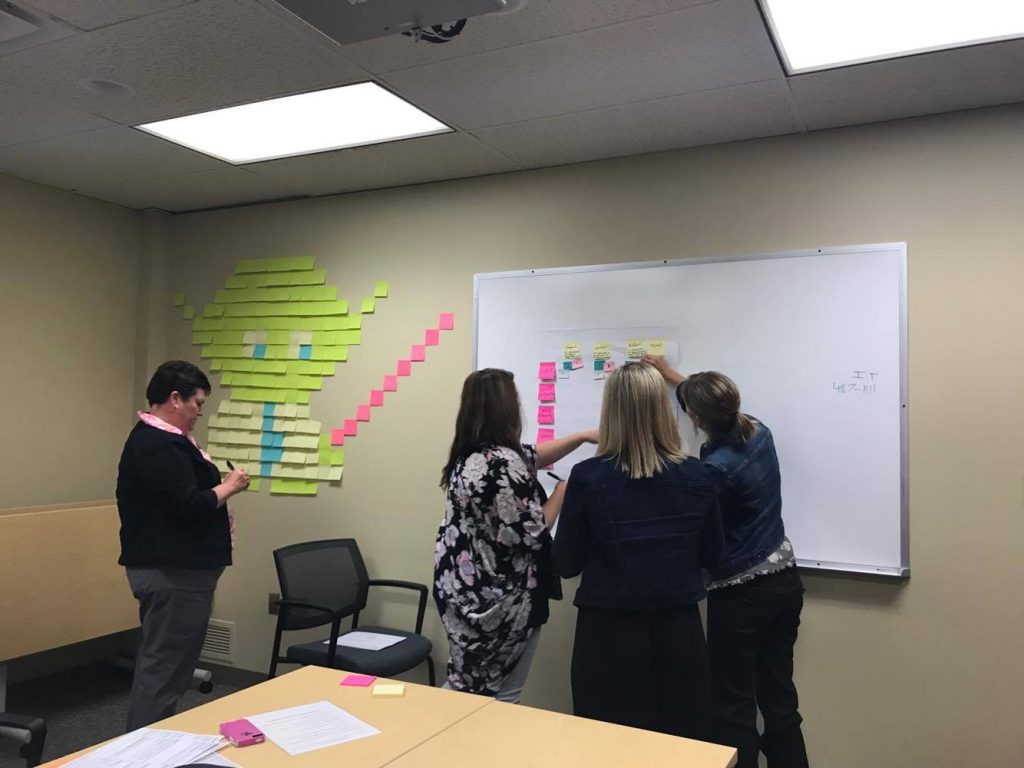
All in all, we have a ways to go on these kaizens but the goal is to have at least something changed in each of these areas by April 2018, and to reassess after this year’s commencement ceremony. A foot in the door for lean, just as the students are about to leave.
With the Rio 2016 Summer Olympics among us and being proud Americans, you probably can’t even go to the grocery store without something or someone blaring “USA! USA! USA!” amid chanting crowds. Can you blame us? We’re up to 83 medals in two weeks, and Hello! Katie Ledecky! Breaking a world record while winning a gold medal by *cough* ONLY 11.38 seconds! That’s pretty cool and yes, GO USA! However, moving passed the idea of the stripes and stars, I’m more interested in the arena Katie took her gold in, and that was in a swimming pool-the kind with swim lanes.
Swim lanes are a tool that is depicted through a diagram. How this tool works is to show the flow of a process or the crossing of many areas of a process and doing so visually. To aid in understanding the steps, an example represented by the progression of the tool will be shown below with a description of each step. This example shows a student who needs to get into a class that has already reached it’s maximum capacity and can’t register for it so they request an exception.
How a swim lane is kicked off is through identifying who touches the process. This “who” can be an individual, a group, a department, an object, or basically anything that physically touches the process. For our example, the who’s include the student, academic advisor of the student, and the professor of the class being registered.
Once the “who’s” are identified, the what’s need to be added. These “what’s” are the current processes that each “who” goes through and how each others processes relate to one another. This is also where you identify where each “who’s” process starts. The process for our example starts with the student and moves to the professor then to the advisor and back to the student.
The third step is where the “what” is examined and analyzed for where there is waste within the process or steps and that don’t add value. For our diagram, there is a waste of time between the time the student makes the request and actually hears back that they can register. This is a waste because it is waiting time. There is also waste for the student: once they are able to register they have to do it very quickly so that another student doesn’t register when they see an open or an “extra” seat. There’s also waste for the professor: they need to do re-work of their classroom to be able to accommodate an additional student.
Through the use of swim lanes you are made to focus on the basic steps to figure out what is actually happening in a process, and once that is done, you are able to then dive into the process and figure out where the defected or problematic areas are and can then get to the root cause. This aids you in being able to see the big picture. Often times we have a process that is “broken” and we become frustrated and redo the entire process just to find that it didn’t reduce the frustration. However, through the use of swim lanes you are able to see the whole process and establish what part(s) of the process is/are broken and can devote your time and energy into making improvements to that specific area without redoing the whole thing. So just like Katie Ledecky, if we take one [free-style] stroke at a time, we can come out in record time.
Any college student from around the world will tell you how fast-paced and hectic it is trying to figure out the rest of your life. Between classes, student organizations, figuring out our financial situations (and trying not to drown in them), and truly trying to enjoy this time in our lives, students are busy! Likewise, any professional in the workforce will tell you the same thing–being an adult isn’t easy. Can it all be done?
Process mapping and standard work for any task allows for smoother running and less stressful experiences with better outcomes. In one of my classes this week, we looked at the writing process for a research document. It was highly recommended to be taken a step at a time so as to not overwhelm the writer. The paper is to be taken piece by piece and improved upon gradually. The writers were advised to take detailed notations of their process goals in order to complete all of the necessary tasks in a timely manner and fully report on all of the key points of their topic. Things cannot be made without time and effort, and one can’t do everything at once.
Lean principles are everywhere and, if studied, are not difficult to implement. Many people misconstrue continuous improvement as solely a manufacturing or workplace fad. In reality it can be applied in many aspects of your daily routine to provide a more organized, efficient, and beneficial way of doing things. How do you use Lean in your everyday life?
Last week, The Rozsa Center for the Performing Arts held a kaizen event to improve their rental processes. The current process is inconsistent and very confusing for all parties involved including the client, rental staff, administration, production staff, Ticketing Services, and Catering. In order to see what the current state of the process is, the team decided to map out the process by way of a swim lanes process map. Before the team began creating the process map, Bob Hiltunen-Director of Auxiliary Services, provided some great process mapping guidelines that really helped the team. They are:
- There is no right or wrong way to map
- You don’t learn how to process map, you process map to learn
- Process map what is, not what you would like it to be
With these guidelines in mind the team was able to create a process map that included each department/area that the process touches and all of the process steps from start to finish (see image below).
With the initial map created the team was then able to move forward in creating an “ideal state” process map. The ideal state captures the process in a perfect world with all the necessary resources available. The team was able to look back at the current state map to compare steps and people involved with the ideal state map. The team will continue to work on their ideal state in the next few weeks and then form a plan to move from current to the ideal. Check back to see the final results in a future post.
Today we’re cross-posting an article written by Wendy Davis for Michigan Tech’s Human Resources News blog.
NamGiao Tran just ended her six week internship with Human Resources. Nam was a MICUP student visiting Michigan Tech from Grand Rapids Community College.
Nam’s internship project in Human Resources focused on making improvements to the internal flow of work related to a staff hiring. Her first week began with learning about Lean philosophy and focusing on the concept of standardized work. She began by working with department staff to understand the hiring process and creating a swim lane process map. The exercise of creating the process map identified specific improvement areas which Nam worked on for the remainder of her stay. Her work supported the creation of standardized tools, forms, and checklists that will be implemented to improve the process flow.
Nam is pictured below with her poster that captures the work she did. The photo was taken at the MICUP Poster Presentation on June 19, 2014.
Nam plans to transfer to Michigan Tech next fall to study Accounting.
The Office of Continuous Improvement’s first ever Process Mapping Workshop came to a close yesterday. There were five Kaizen teams each working on a process of their choosing. Each team spent 2.5 hours on Tuesday and again on Thursday working on a current-state process map using a lean tool know as “swim lanes.” The groups reported out on Thursday afternoon with each map taking on its own unique form.
Our facilitating group was made up of Ernie Beutler (Dining Services), Kathy Wardynski (Dining Services), Laura Harry (Memorial Union), Ruth Archer (Office of Continuous Improvement), and Theresa Coleman-Kaiser (Asst. Vice President for Administration). Our team leaders consisted of faculty and staff from a few different areas of the university: Gina Dunstan (Humanities), Madeline Mercado-Voelker (Human Resources), Heidi Reid (Human Resources), Kathy Wardynski (Dining Services), and Sandra Kalcich (Dining Services).
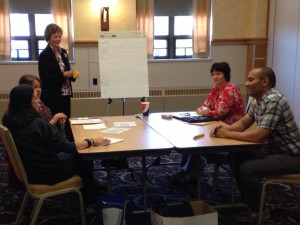
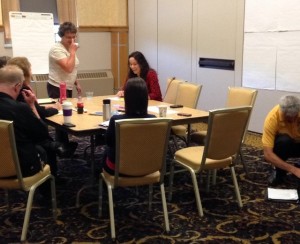
Our team leaders and facilitators were very excited to see and be a part of the process of process mapping, and were shocked to see just how complicated some of these Tech jobs really are. All in all, it was a great two days of mapping and we hope to see some fresh faces at our next workshop. More details on that coming soon!
